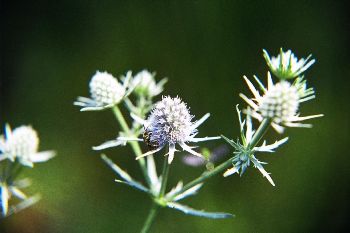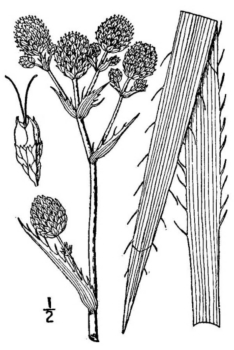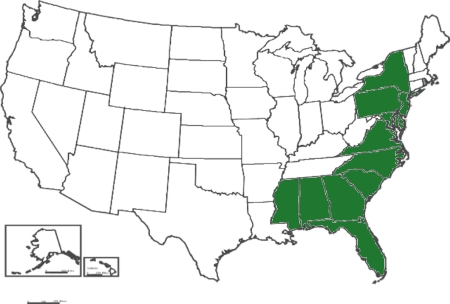Eryngium aquaticum var. aquaticum
 |
 |
photo Renee Brecht |
Britton & Brown |
| Botanical name: | Eryngium aquaticum var. aquaticum |
| Common name: | Rattlesnake master |
| Group: | dicot |
| Family: | Apiaceae |
| Growth type: | forb/herb |
| Duration: | Biennial |
| Origin: | native |
| Plant height: | 1.5'-4' |
| Foliage: | stiff, upright, branched stem, with narrow, pinnately veined leaves. Leaves are not parallel veined to the mid-rib. Upper leaves sessile. |
| Flower: | Round heads of tiny five-parted florets; whitish color often with a bluish to purplish cast, Heads many in a terminal irregular umbel, the leading ones up to 1-1.5 cm. long |
| Flowering time: | Late July into October |
| Habitat: | Salt marshes and tidewater streams |
| Range in New Jersey: | Middle district and Coastal strip. |
| Heritage ranking, if any: | S3 |
| Distribution: |  |
| Misc. | USDA lists as an obligate wetland species; i.e.,��Occurs almost always (estimated probability 99%) under natural conditions in wetlands.
Stone lists as "common" on the salt marshes of the coast from Spring Lake southward, and locally along Delaware Bay and the lower Delaware River, also on tidewater streams some distance from the shore. "A peculiar plant, usually growing with sedges, grasses and other vegetation, its large compound umbels of bluish heads and spiny involucres presenting a peculiar misty appearance at a distance against the dark green of the salt meadows." Note that this species, considered common in Stone's time, is now a species of concern (S3). Sometimes confused with a similar species, Eryngium yuccifolium, but the habitat is different (aquatic vs. drier habitat). Furthermore, the leaf venation in E. aquaticum is not parallel to the mid-rib and the flowerhead bracts are divided into three parts. Eryngion = classical name for some prickly plant; aquaticum = aquatic |